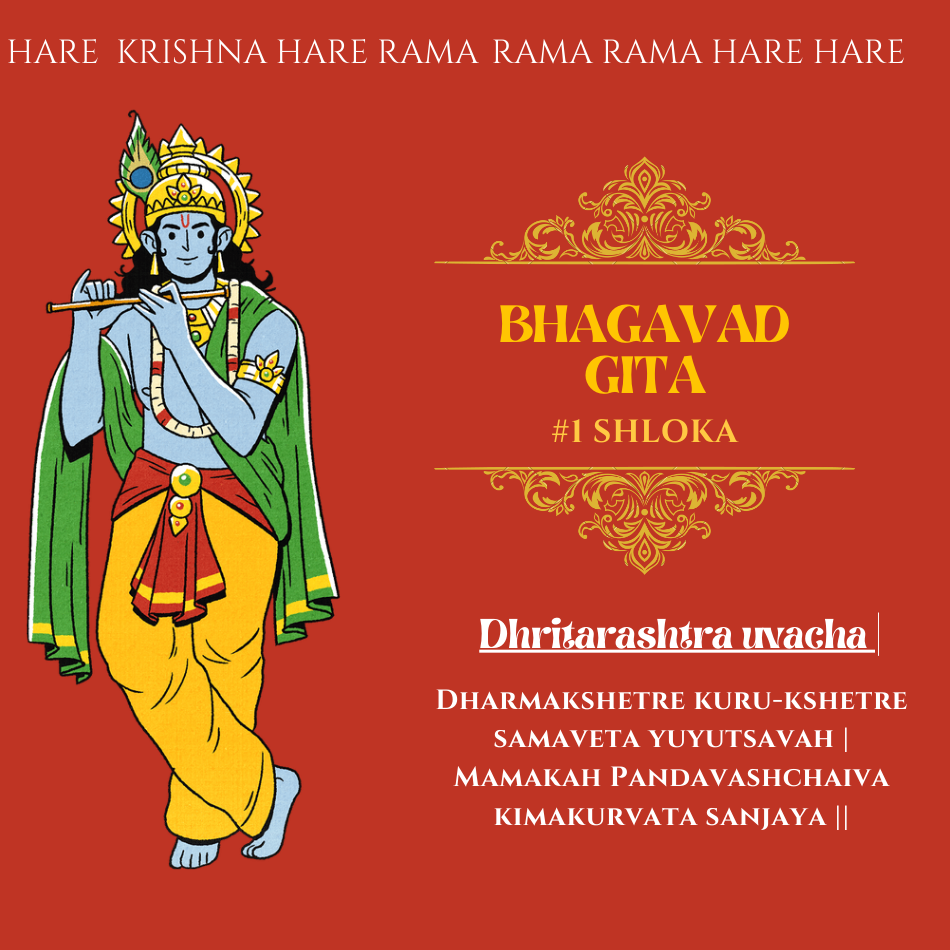Bhagavad Gita is a sacred scripture, and through Sri Krishna, the Supreme Divine, it imparts wisdom to humanity through the questions and answers exchanged with Arjuna. Hence, today we are discussing the meaning of the first verse of the Bhagavad Gita.

| Dhritarashtra Uvacha: |
Dharmakshetre kuru-kshetre samaveta yuyutsavah |
Mamakah Pandavashchaiva kimakurvata sanjaya ||
Dhritarashtra said:
Table of Contents
O Sanjaya, assembled in the holy land of Kurukshetra and desirous of battle, what did my sons and the sons of Pandu do?
9 words from Bhagavad Gita #1 Shloka:
- Dhritarashtra, the blind king of Hastinapura, is addressing his charioteer and advisor, Sanjaya.
- The setting is the battlefield of Kurukshetra, known as Dharmakshetra, which is considered a sacred land for the battle between the Kauravas and the Pandavas.
- Dhritarashtra’s sons are the Kauravas, led by Duryodhana, on one side of the battlefield.
- The sons of Pandu are the Pandavas, led by Arjuna, who is on the opposing side.
- The Kauravas and the Pandavas are eager and enthusiastic (yuyutsavah) to engage in battle.
- Dhritarashtra’s affectionate term “Mamakah” refers to his own sons, the Kauravas.
- “Pandavashchaiva” refers to the sons of Pandu, the Pandavas.
- Dhritarashtra inquires about the actions (kimakurvata) of both the Kauravas and the Pandavas in the battle.
- This verse sets the stage for the great discourse of the Bhagavad Gita, where the philosophical teachings by Lord Krishna to Arjuna take place on the battlefield before the war begins.
9 things we can learn from Bhagavad Gita #1 Shloka
1. The Bhagavad Gita begins with a dialogue between King Dhritarashtra and his charioteer Sanjaya, setting the stage for the spiritual teachings.
2. The conversation occurs in Kurukshetra, a sacred land associated with righteousness and duty (Dharma).
3. The use of “Dharma-kshetra” emphasizes the significance of the battlefield as a place where moral choices and ethical dilemmas arise.
4. The term “Samaveta” indicates the gathering of eager and enthusiastic warriors, ready to fight for their respective causes.
5. The question “kimakurvata” shows Dhritarashtra’s concern about the actions of both his sons (Kauravas) and the sons of Pandu (Pandavas).
6. The shloka highlights the commencement of a great war, symbolizing the conflicts and challenges faced in life’s journey.
7. The verse subtly introduces the idea of duty and righteousness, as the warriors engage in battle for what they believe is right.
8. It presents the theme of the inner struggle and the need for guidance, which will be addressed by Lord Krishna later in the Gita.
9. This verse sets the tone for the profound philosophical discourse that follows, making the Bhagavad Gita a timeless guide to life’s complexities and spiritual growth.
https://youtube.com/shorts/MXfz08wt0gY
For the latest news CLICK HERE
Leave a Reply